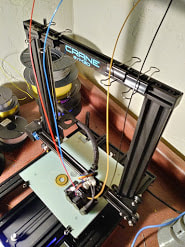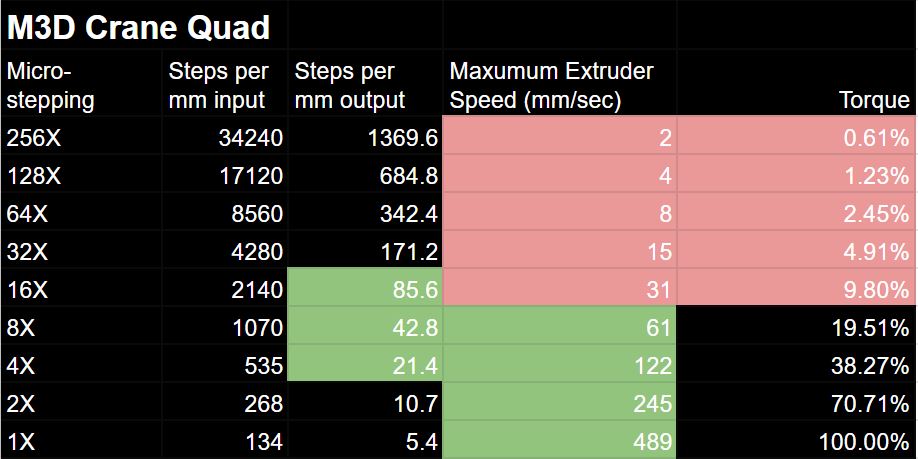M3D Crane Quad blogResources, Thoughts and Comments about the M3D Crane Quad Printer.
Some helpful links: M3D Quad Owners Facebook Group Youtube video on loading filament into your Quad extruder. Post processing Script by Juan Rosario |
|
Fun Fact: Have you ever noticed that the plate in a microwave changes direction almost every other run. This is because the motors have barely enough torque to accelerate the mass of whatever you are cooking. The direction change is intentional and takes advantage of slop in the gear mechanism. When the motor stops turning clockwise the gears are already loaded in that direction. By reversing the motor is able to build up some momentum before the gearing catches up and loads the motor. But how does that have anything to do with 3d Printing or the M3D Crane Quad? Well the answer is fairly technical and my reference to a microwave is abstract at best. To put things in context, I have been trying to sort out issues with extrusion consistency. If you think of the business end of a 3d printer as a fancy hot glue gun, it is extremely important to control the amount of plastic getting pushed through the hot end. Too little extrusion leads to gaps in the print where it can break and too much creates all manner of cosmetic issues like blobs, warts and stringing. Too much extrusion may even result in plastic building up proud of the layer being printed and can catch on the hot end resulting in stringing or worse, horizontal layer shifts. So far my experience with the M3D quad the machine seems to sometimes push too much plastic and other times seems to struggle to push the filament at all. All of the motions on a 3d printer are performed using stepper motors. An oversimplified explanation of a stepper motor is a DC electric motor where the rotation is divided into some number of equal steps. Typically, desktop 3d printers use Nema 17 steppers that have 200 steps (1.8 degrees per step). For the Quad printer, M3D is using their own proprietary motors that are very compact and light. Control over motors utilizes a function called microstepping that allows the motor to smoothly interpolate between these steps. The level of microstepping is expressed in multiples of two (2x, 4x, 8x, 16x, 32x, 64x…) The higher the microstepping the more precise, smoother and quieter the motion. Also, are potentially less resonance as the motors are not stopping only at incremental positions. Doing some research on this I stumbled across an interesting inconsistency in M3D's documentation. The Quad firmware uses a file called motion.g that sets the parameters for how the motors function on the machine. By default the current settings in the Quad printer firmware is set up with 16X microstepping for the extruder motors. However, on their documentation for the quad head when sold as a separate unit M3D recommend using 8X microstepping as a starting point. Intuitively it seems that higher microstepping may result in less torque. That seems to be supported from various sources online. But documentation from Duet (the makers of the control board for the Quad printer) indicate otherwise. None the less I reconfigured my motion.g file to 8x microstepping, re-calibrated and results seem to show much more consistent performance. My rationale is that even at 8x microstepping the Quad motors are running at 1070 microsteps per mm. (The number of microsteps to push 1 mm of filament). While it is debatable how much this actually affects torque, another variable is speed. At lower microstepping, the motors can run at higher speeds. This maximum speed could come into play with retraction settings. Retraction is essentially pulling the filament back away from the hotend, typically to reduce stringing when the printer is making non printing moves. I am not certain but it appears to me that 16x microstepping may limit the speed of the steppers to about 30 mm/sec. Which is about half the speed typically used for retraction. So there is the theoretical background. I have included a table below with some calculators based on the above assumptions. The next step is to devise some tests to determine if microstepping has a measurable impact on consistency, speed and accuracy. Reference Documents: M3D Crane Quad Motion.g M3D Quad Head control recommendations HOW ACCURATE IS MICROSTEPPING REALLY? Choosing and connecting stepper motors (Indicates microstepping does not affect Torque) Microstepping: Myths and Realities (Indicates Microstepping has a negative impact on Torque) WHY 16X MICRO STEPPING IS A BAD IDEA WITH MIXING HOT END (A case for higher microstepping)
0 Comments
Leave a Reply. |
AuthorPlease note I am a user of this product and in no way affiliated with the M3D Company. Your mileage may vary. Archives
January 2020
Categories |


 RSS Feed
RSS Feed